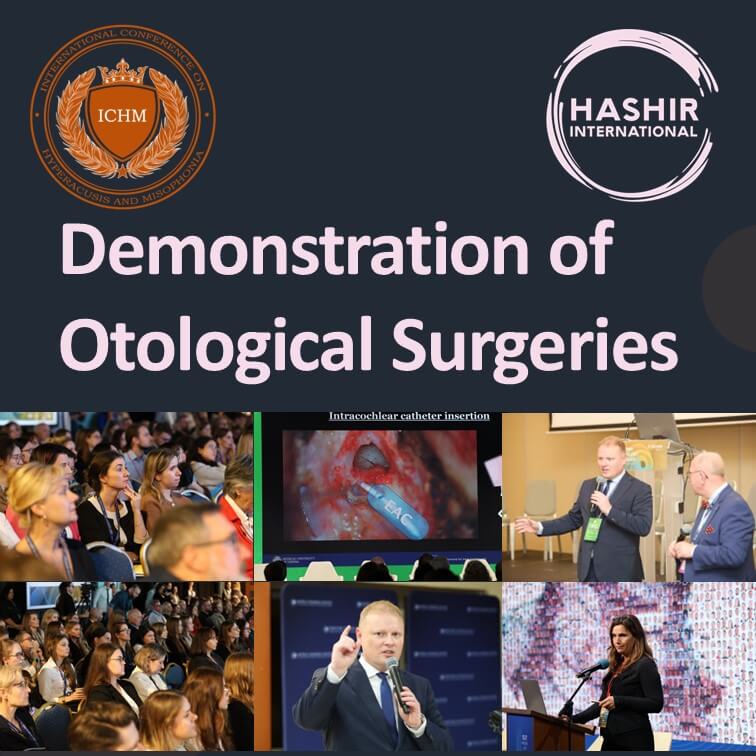
Research studies suggest that certain ear operations e.g., cutting a tendon in the middle ear to reduce noise-induced pain, covering parts of the cochlea from the inside of the middle ear to reduce vibrations in the inner ear, and cochlear implantation can help hyperacusis. At the World Hearing Centre, Kajetany, Prof. H. Skarżyński & Prof. P.H. Skarżyński from Institute of Physiology and Pathology of Hearing (Warsaw, Poland) demonstrated the surgical procedures “live” for an audience of over 500 doctors and specialists from around the glob who took part in the 7th International Conference on Hyperacusis and Misophonia, the 59th Inner Ear Biology Workshop, and the UCHO 2024 – National Conference on Paediatric ORL on 15th September 2024. They demonstrated a wide range of operations from cochlear implantation to bone anchored hearing aids and many more.
World Hearing Centre, Institute of Physiology and Pathology of Hearing, and the Institute of Sensory Organs (Kajetany, Poland) was the host of the 7th International Conference on Hyperacusis and Misophonia (ICHM7) from Sunday to Tuesday, 15 – 17 September 2024 in Warsaw. Honorary President if the conference was Prof. Henryk Skarżyński and the co-presidents were Prof. Piotr H. Skarżyński, and Dr Hashir Aazh.
What do we know about otological operations for management of hyperacusis?
Dr Kim and colleagues assessed the effects of middle ear tendon resection in 37 patients. Their results suggested that the average uncomfortable loudness levels (ULLs) improved significantly after the surgery (follow-up period of about 16 months). There was no significant change in hearing thresholds. Subjective complaint of hyperacusis was recorded in 22 out of 37 patients before the operation, which reduced to two out of 2/37 after the operation. It is important to note that although the average ULLs improved compared to pre-operation, the pre-operation ULLs in most patients in their study were over 90 dB HL, which is much better compared to the average ULLs of less than 80 dB HL which is typically reported among patients with hyperacusis. So further research is needed to explore if this operation can help patients with “pain hyperacusis” which often have ULLs of less than 80 dB HL (some patients with pain hyperacusis have ULLs of less than 30 dB HL). See Dr Aazh’s research on severe hyperacusis which is published in the Journal of the American Academy of Audiology here. Dr Silverstein and colleagues assessed the effect of oval and round window reinforcement surgery on hyperacusis in 40 patients. Their results showed that the score of hyperacusis questionnaire (HQ) reduced from 30.7 to 15.9 and average ULLs increased (improved) from 71 dB HL to 84 dB HL one 1 month after the operation. The mean pre-operative hearing thresholds was about 25 dB HL, which increased to about 32 dB HL after the operation. It is possible that the elevation of hearing thresholds observed following the operation explains the reduced loudness perception for most sounds, thereby increasing the ULLs. This study shows promising results for oval and round window reinforcement surgery, but future studies with control groups are needed. Dr Ramos Macias and colleagues compared hyperacusis symptoms as measured via the Sound Hypersensitivity Questionnaire (SHQ) on 16 cochlear implant recipients. Patients had unilateral hearing loss, with one ear fulfilling cochlear implantation criteria, and an additional severe tinnitus impact. They reported a significant change in SHQ score 12 -months after the implantation as a secondary benefit of the treatment. Their study had a very small sample size and no control group.
Overall, these studies show promising results. Future studies with randomized controlled trial design are needed to assess the efficacy of these procedures before they can be offered to patients as a treatment choice for hyperacusis.
